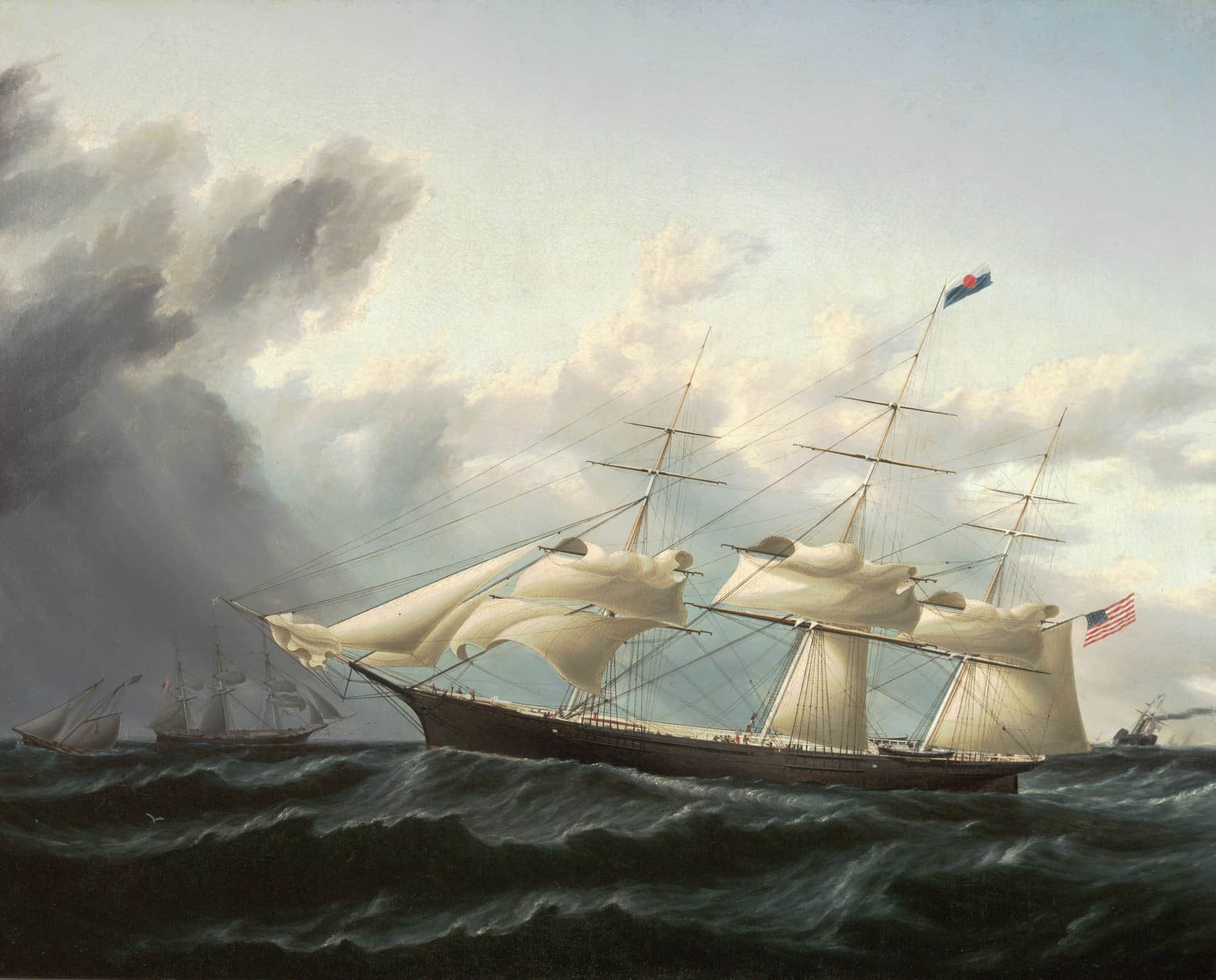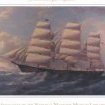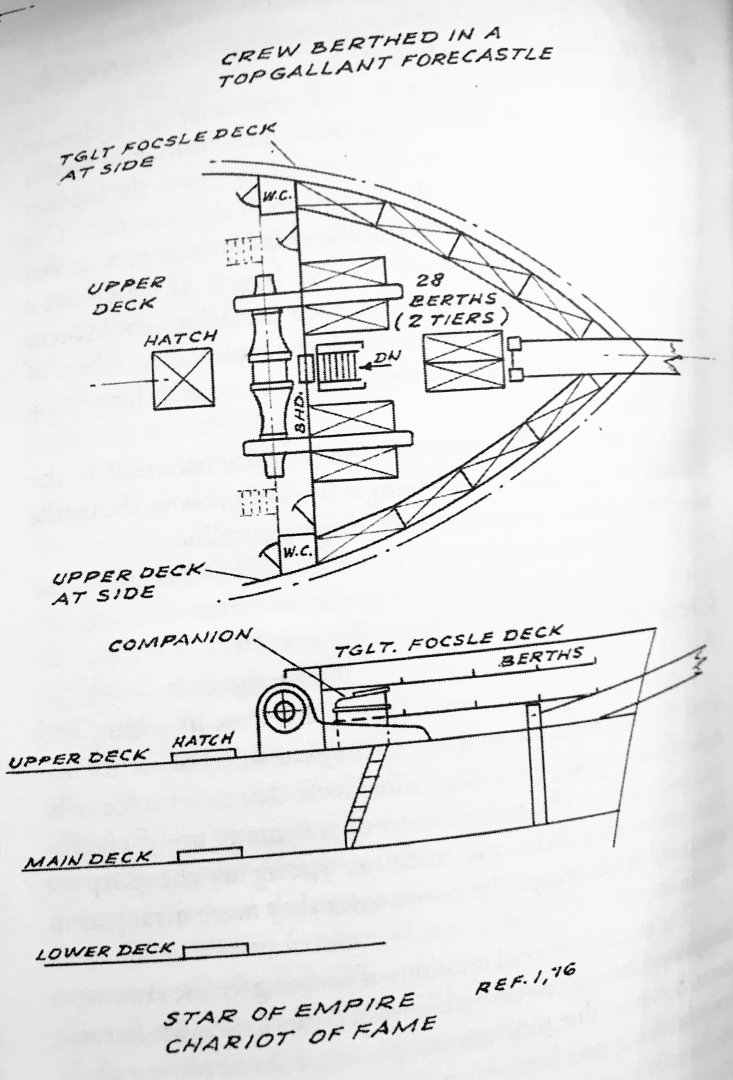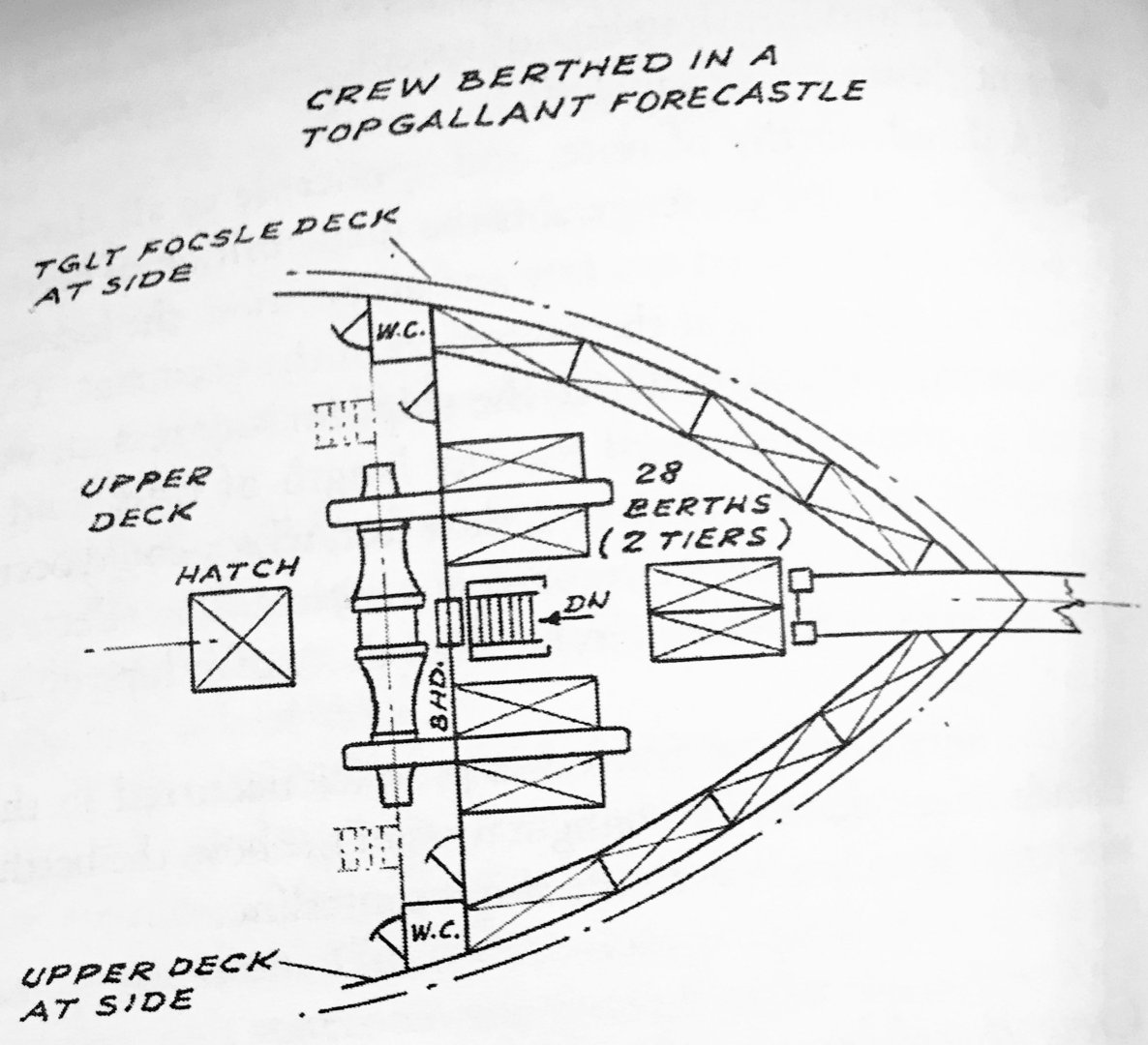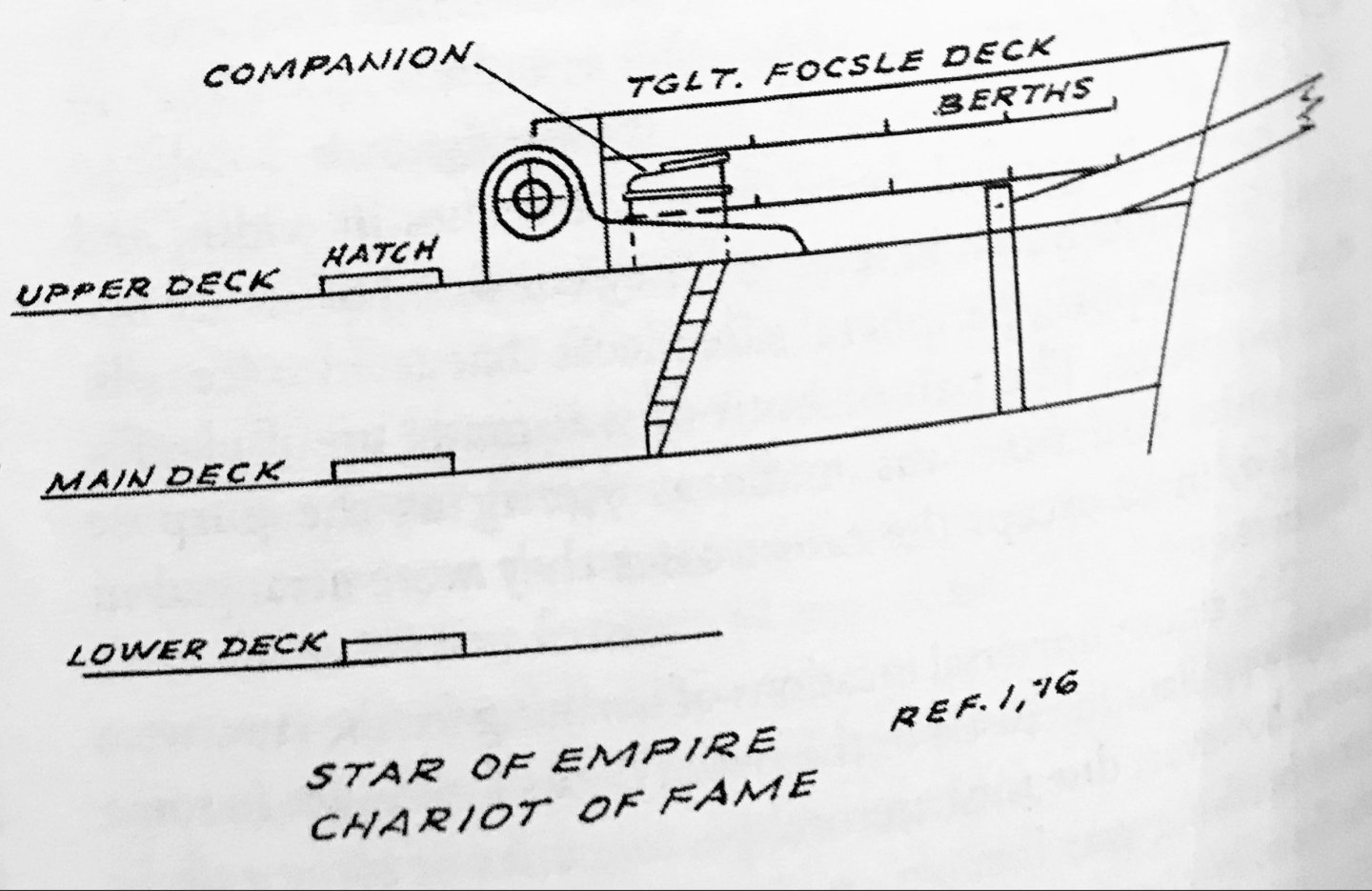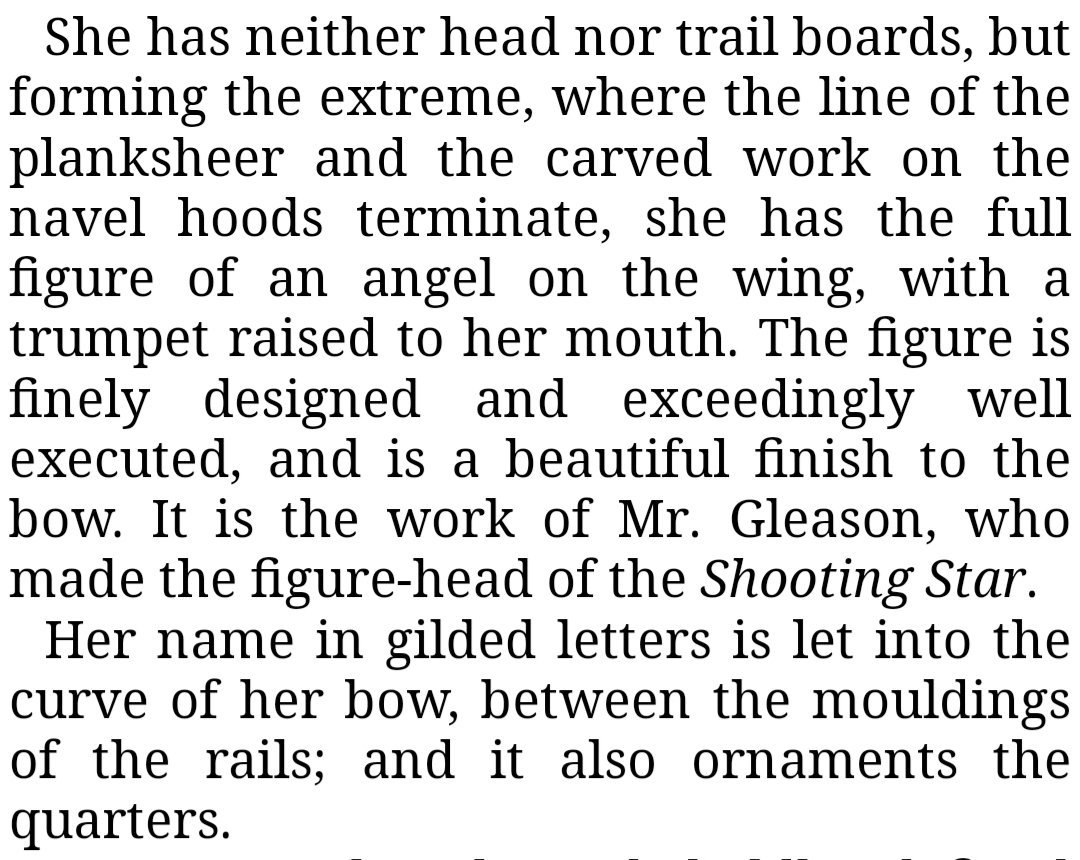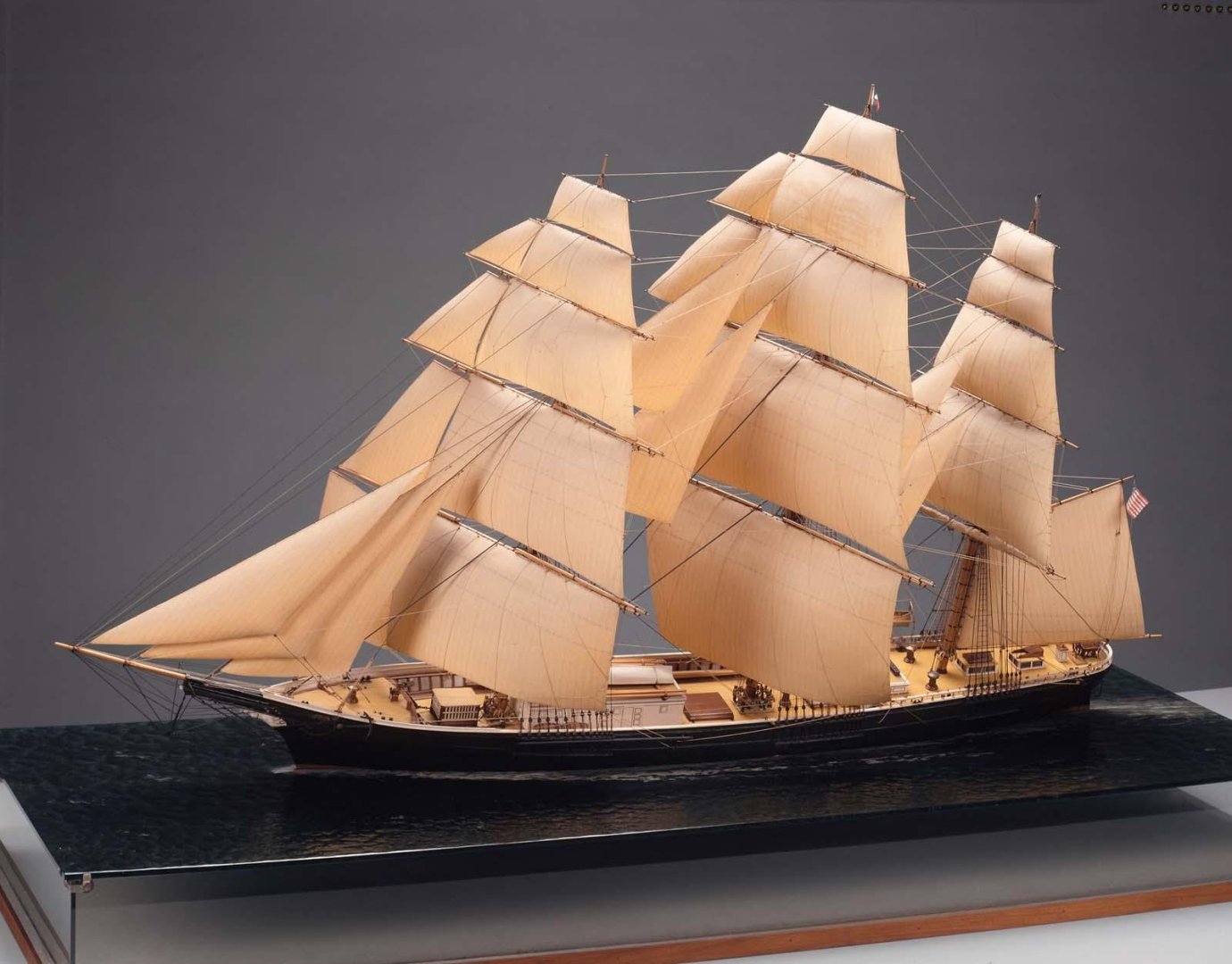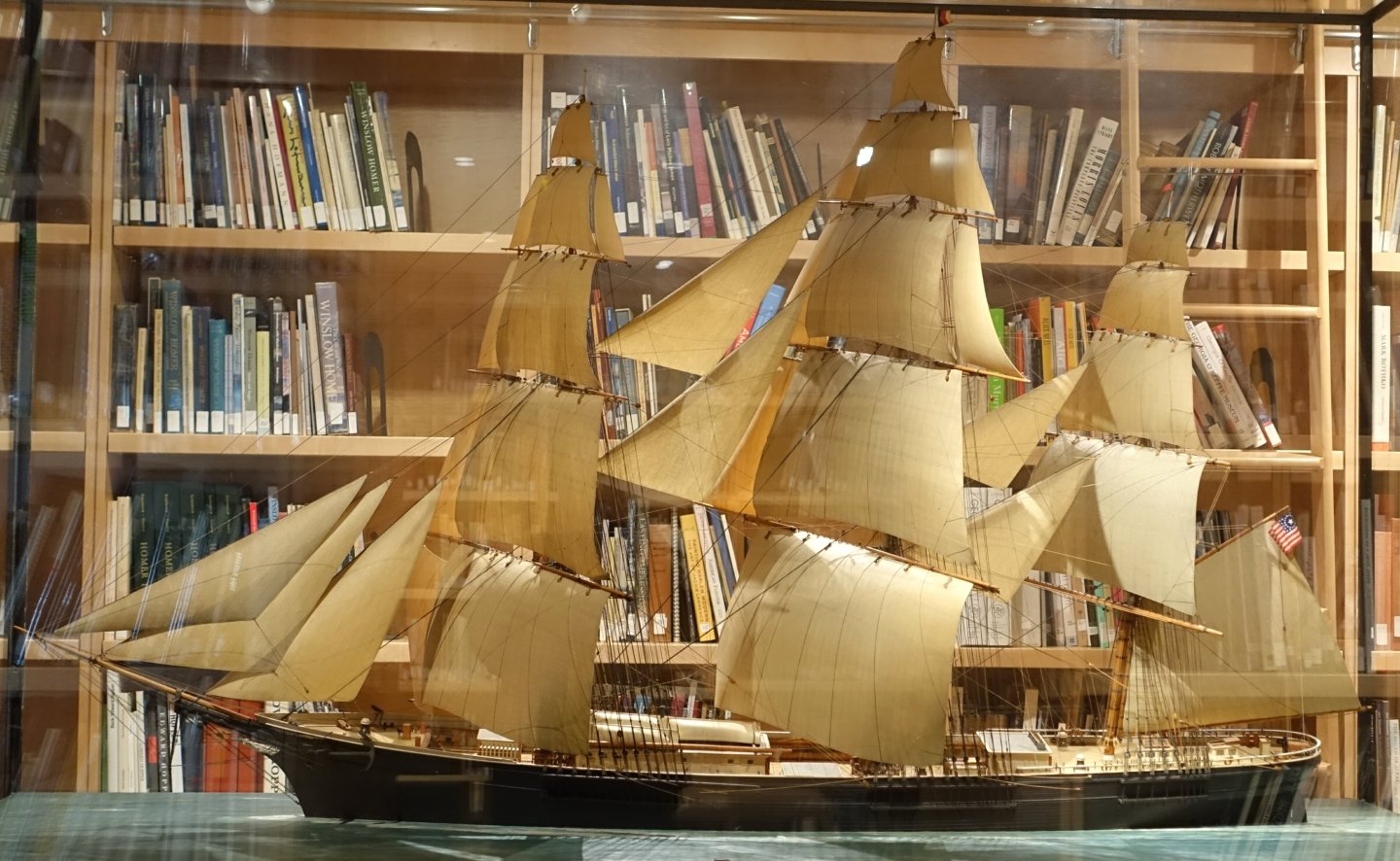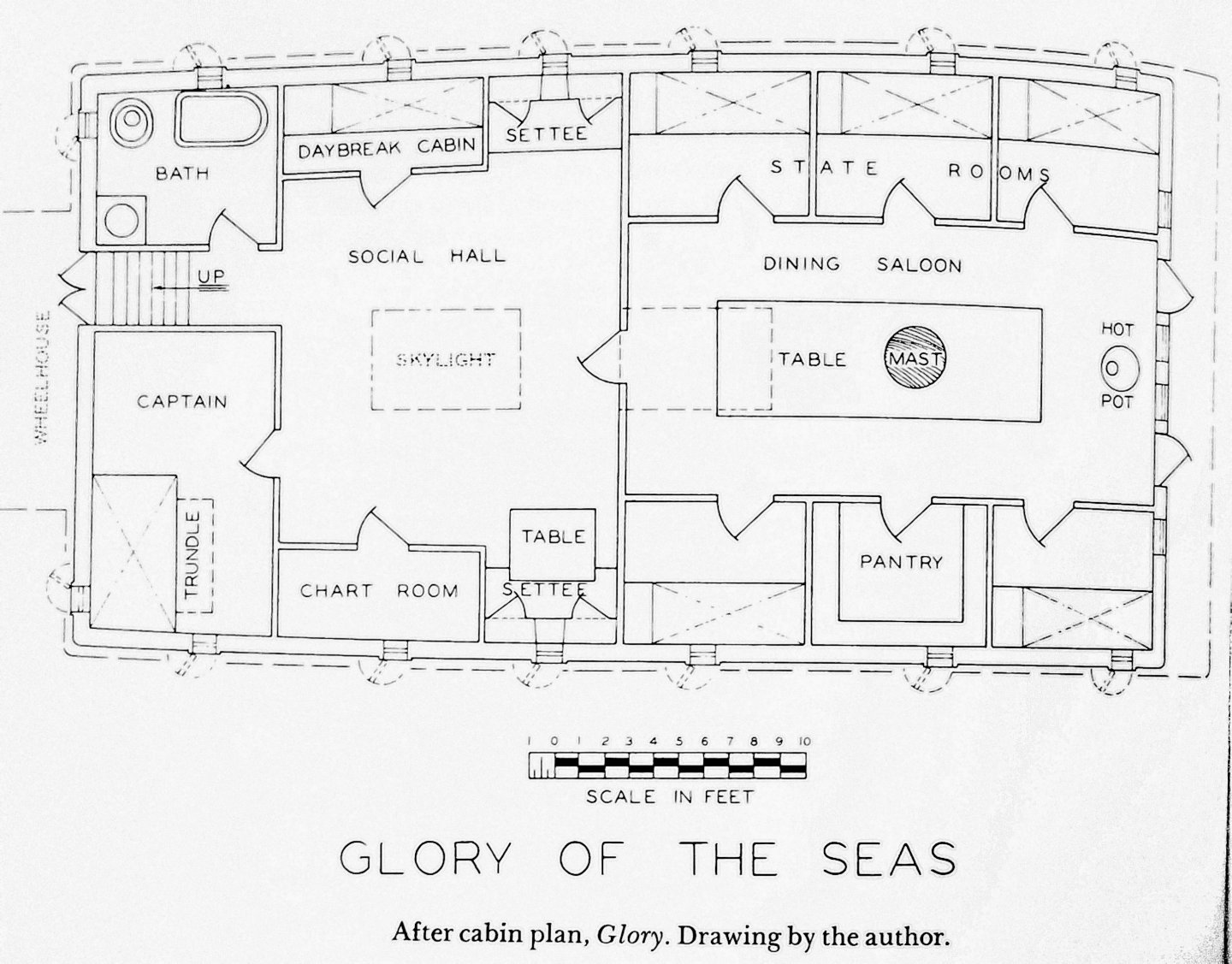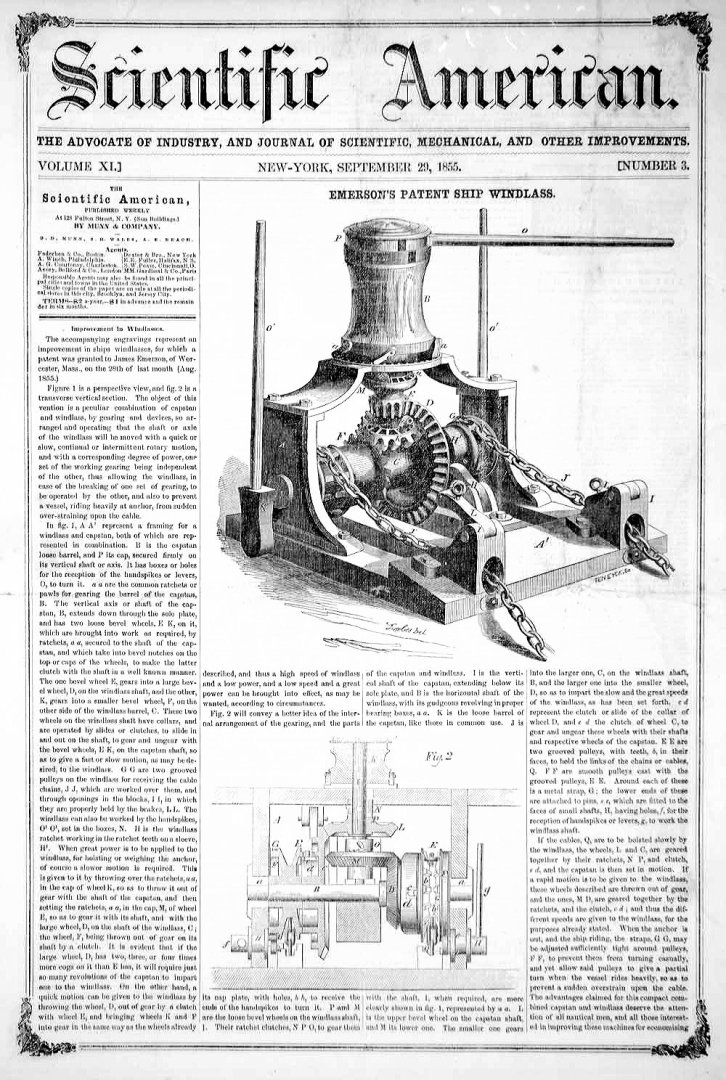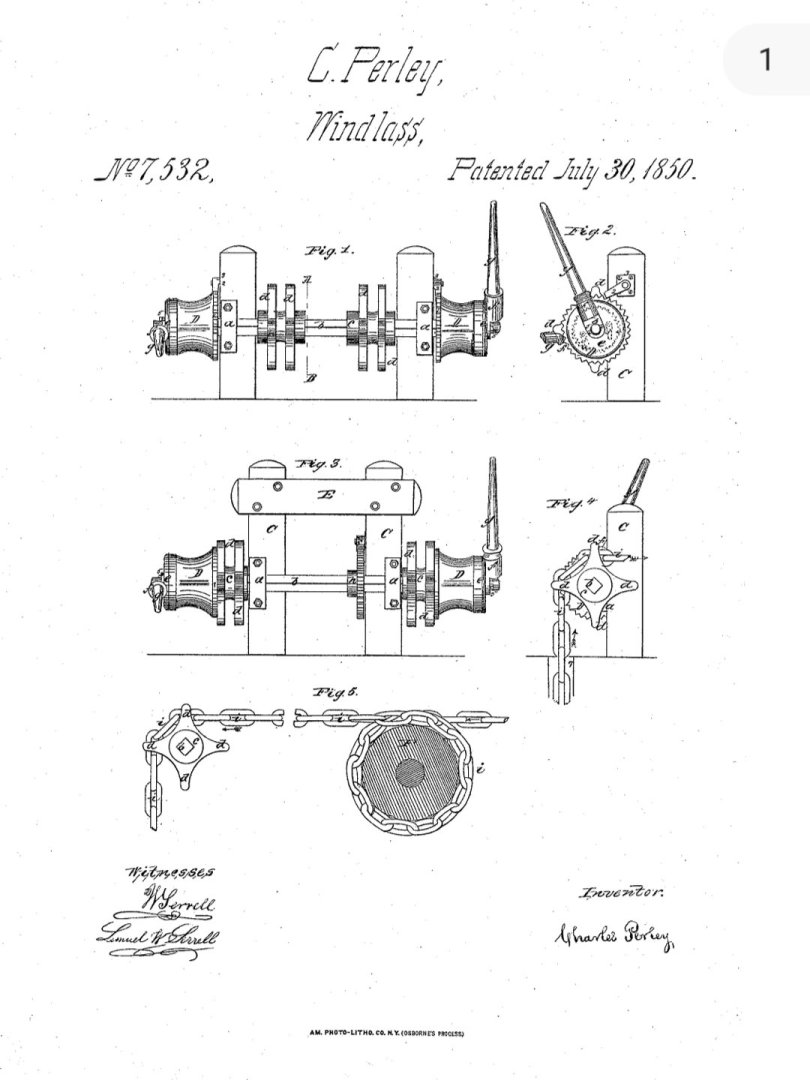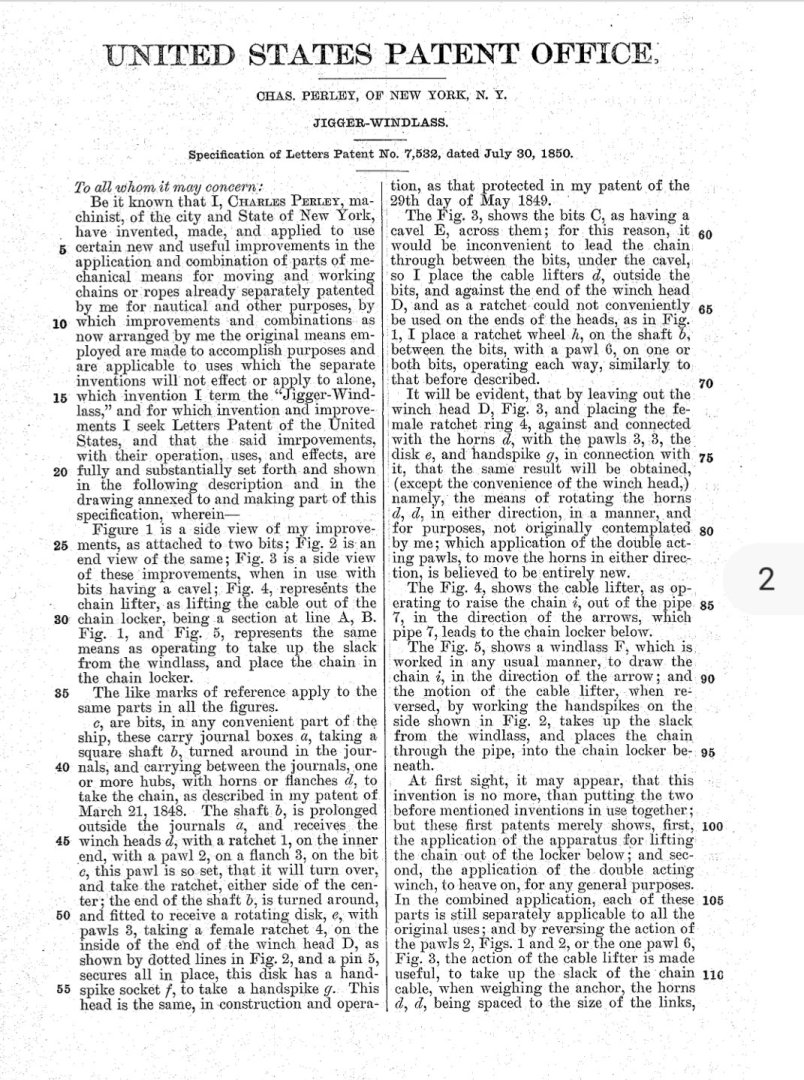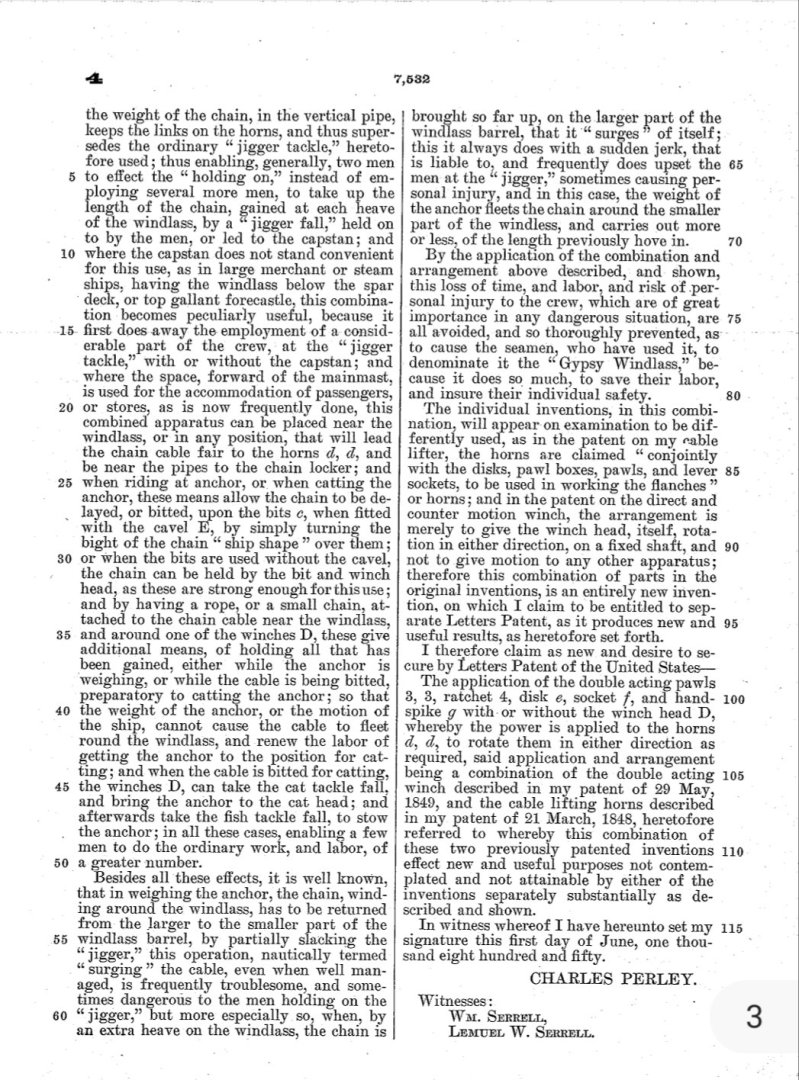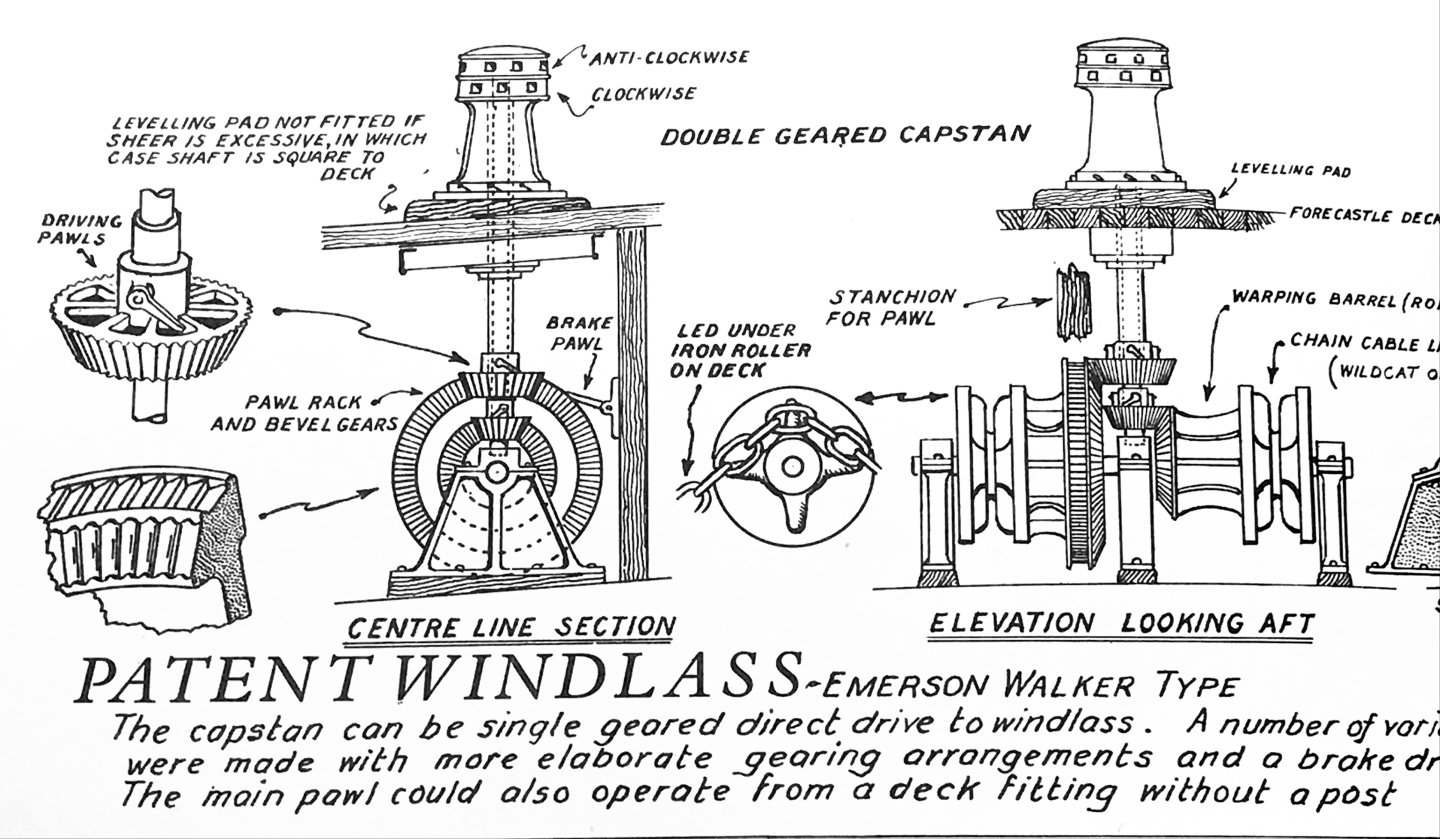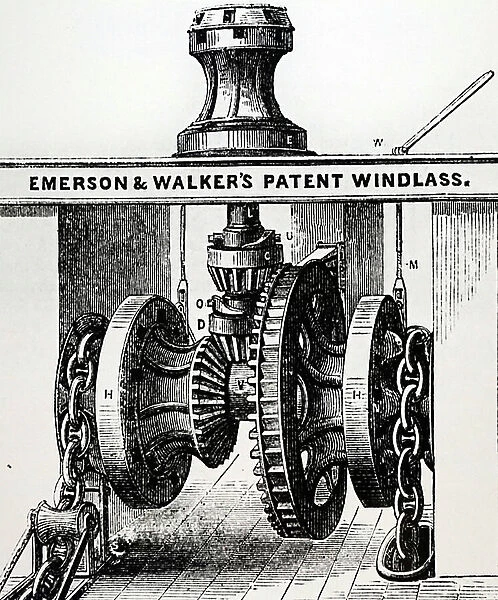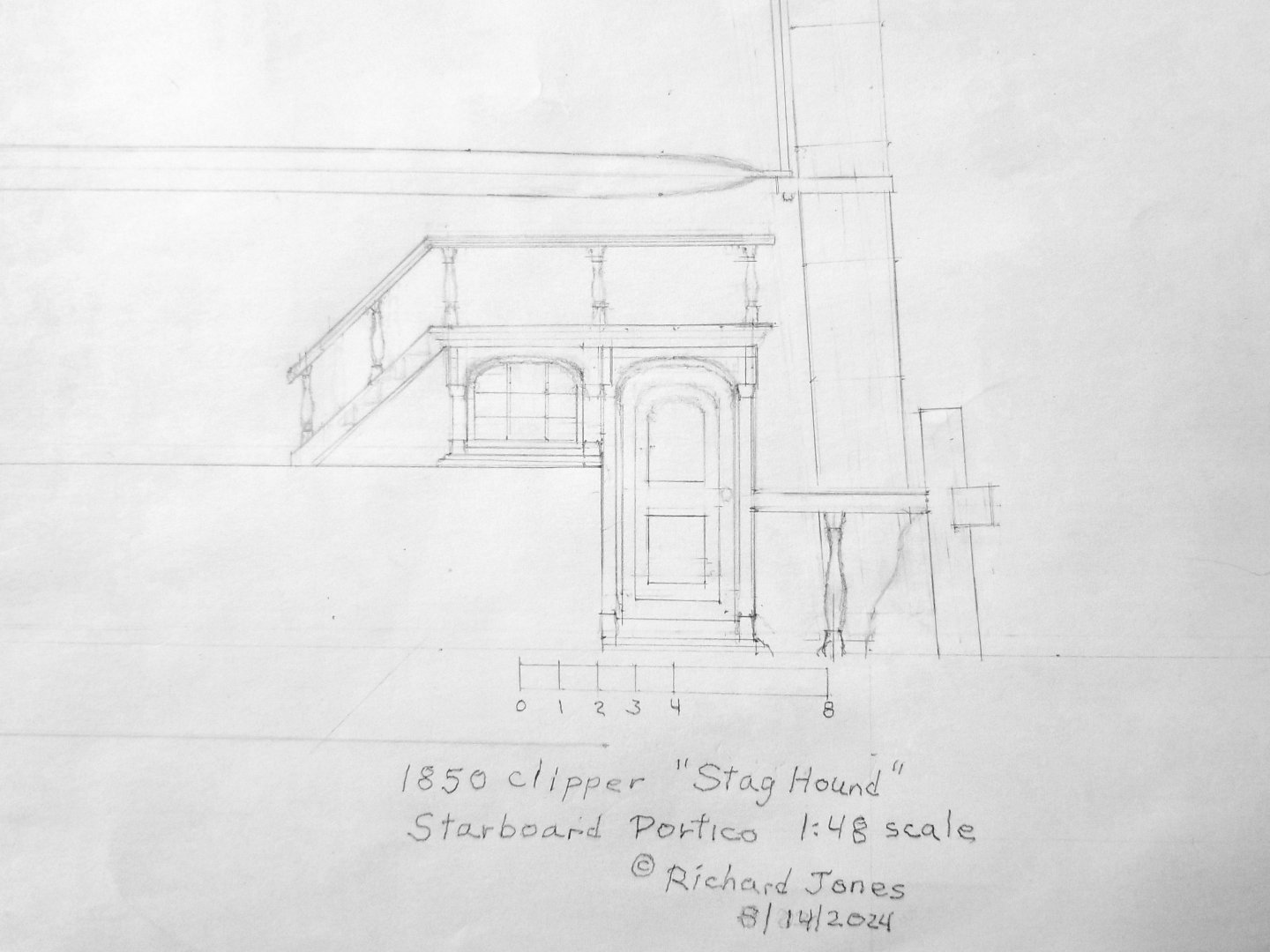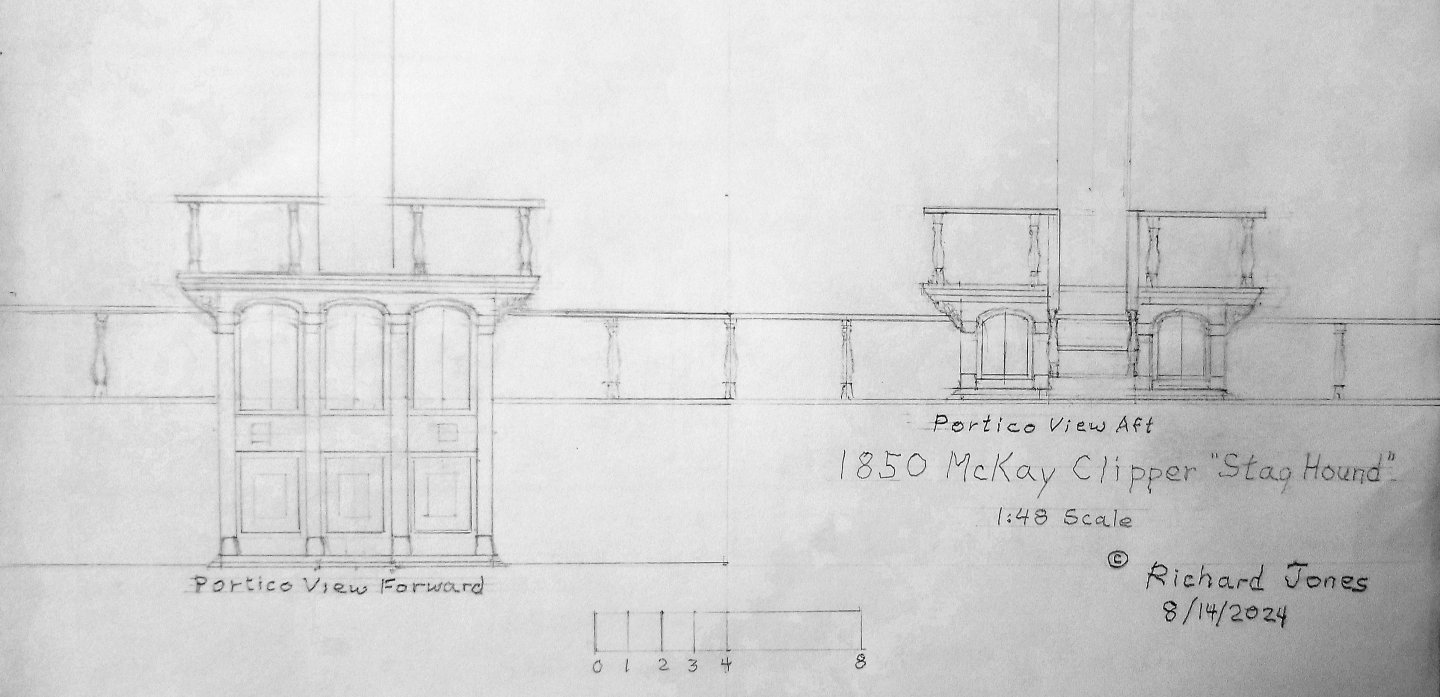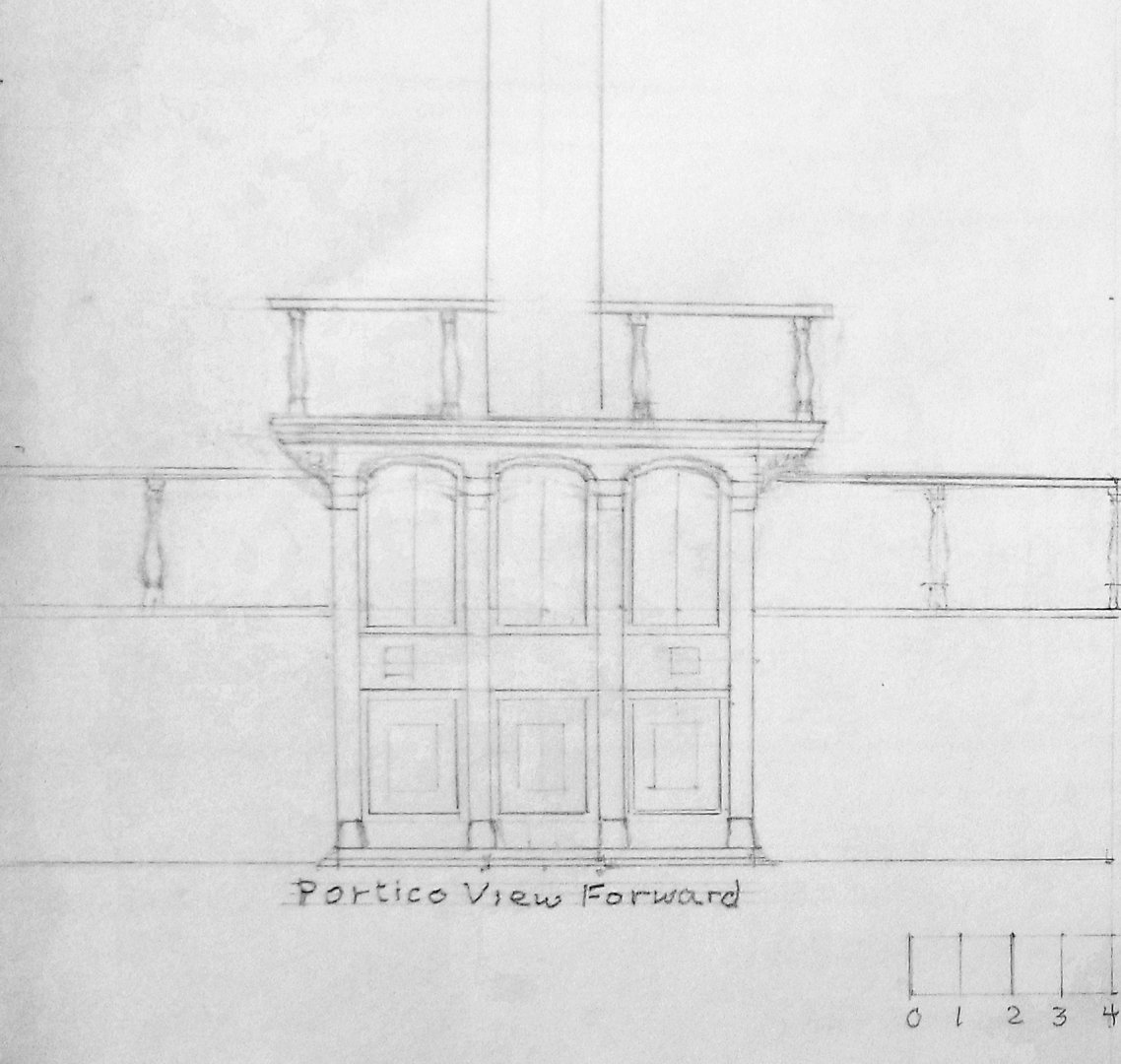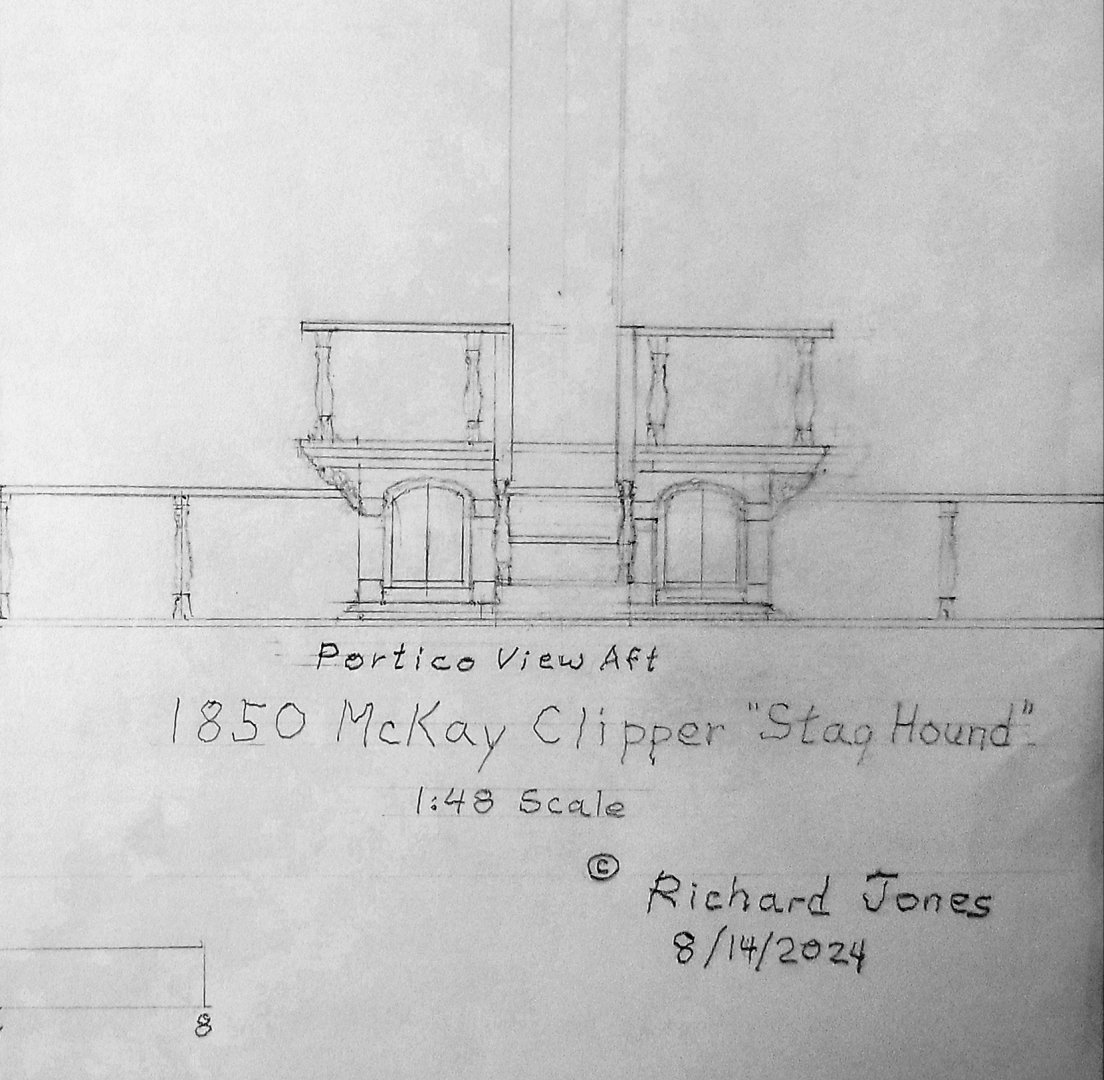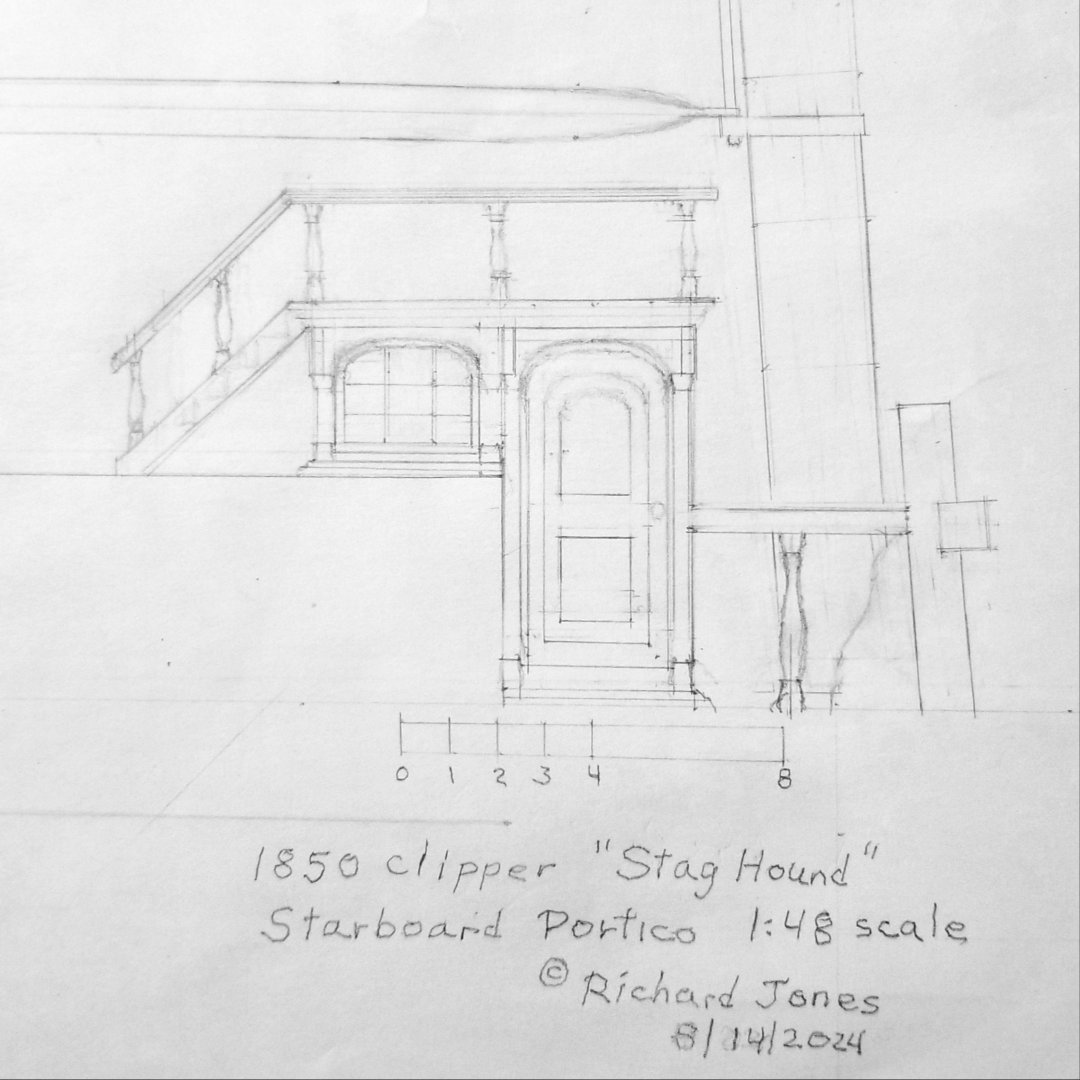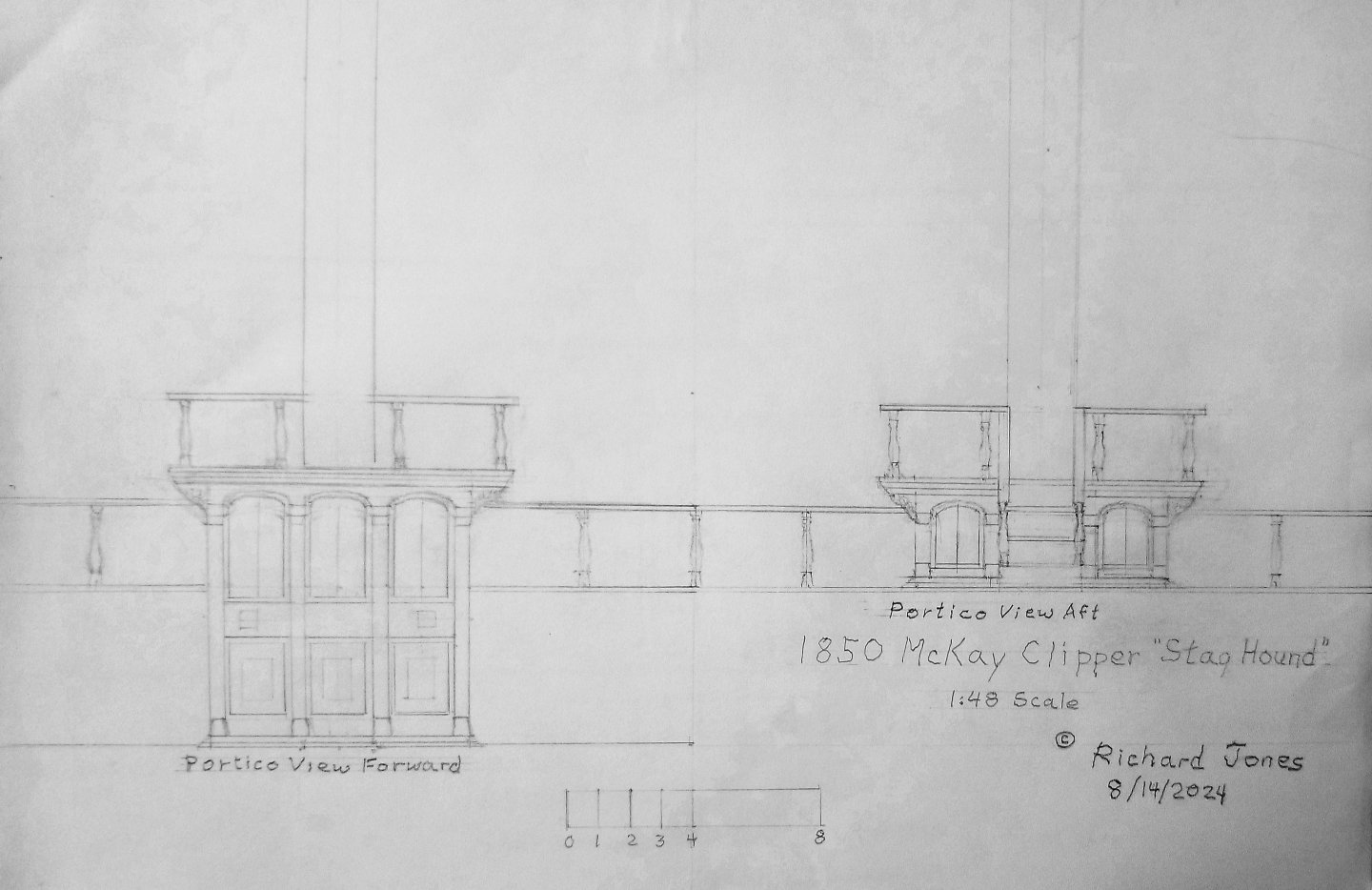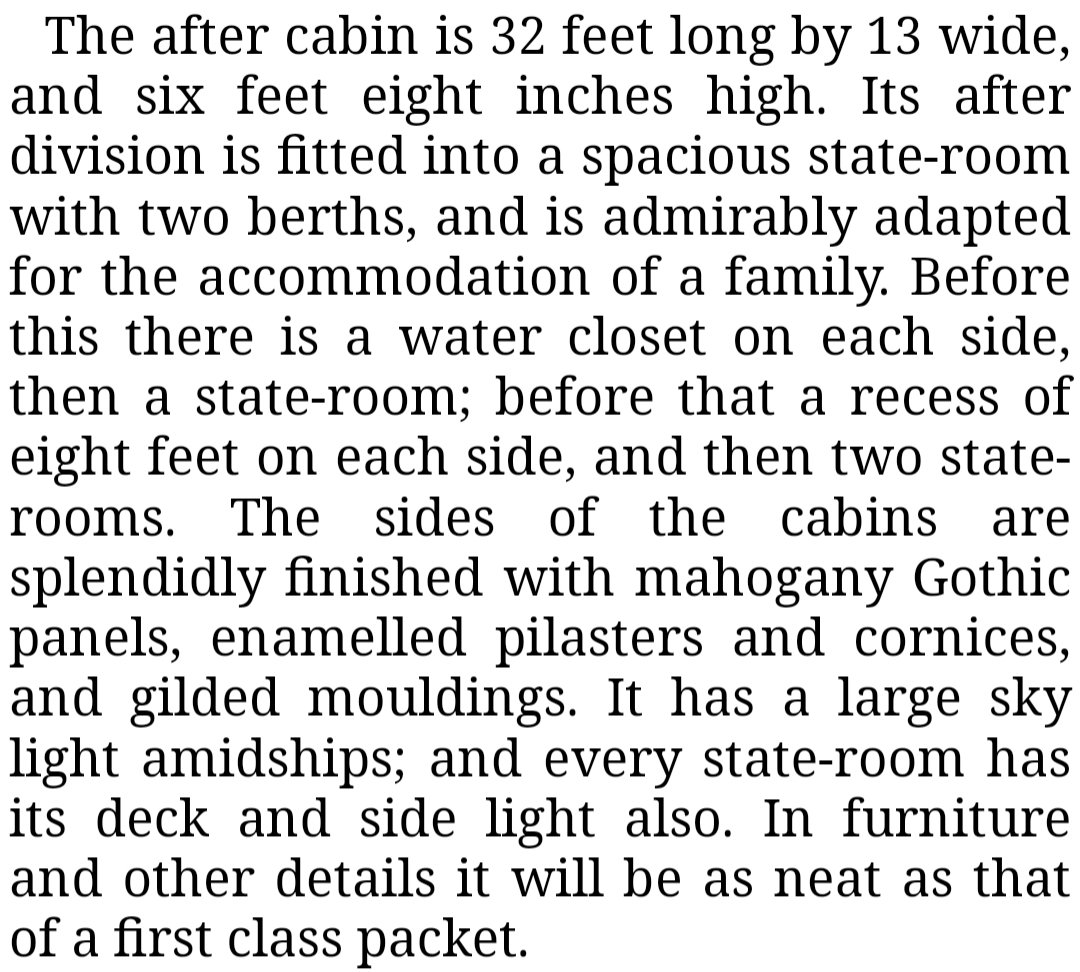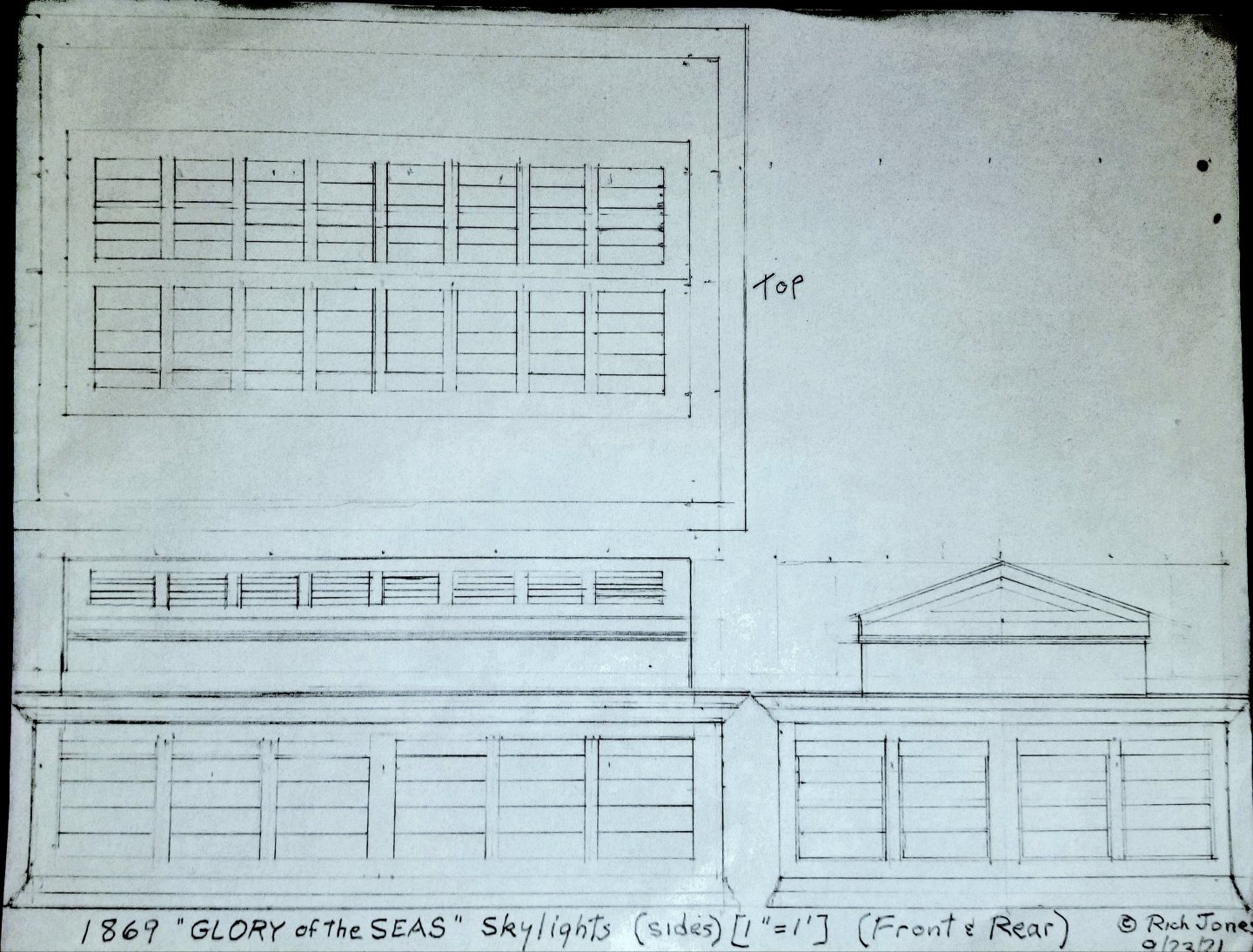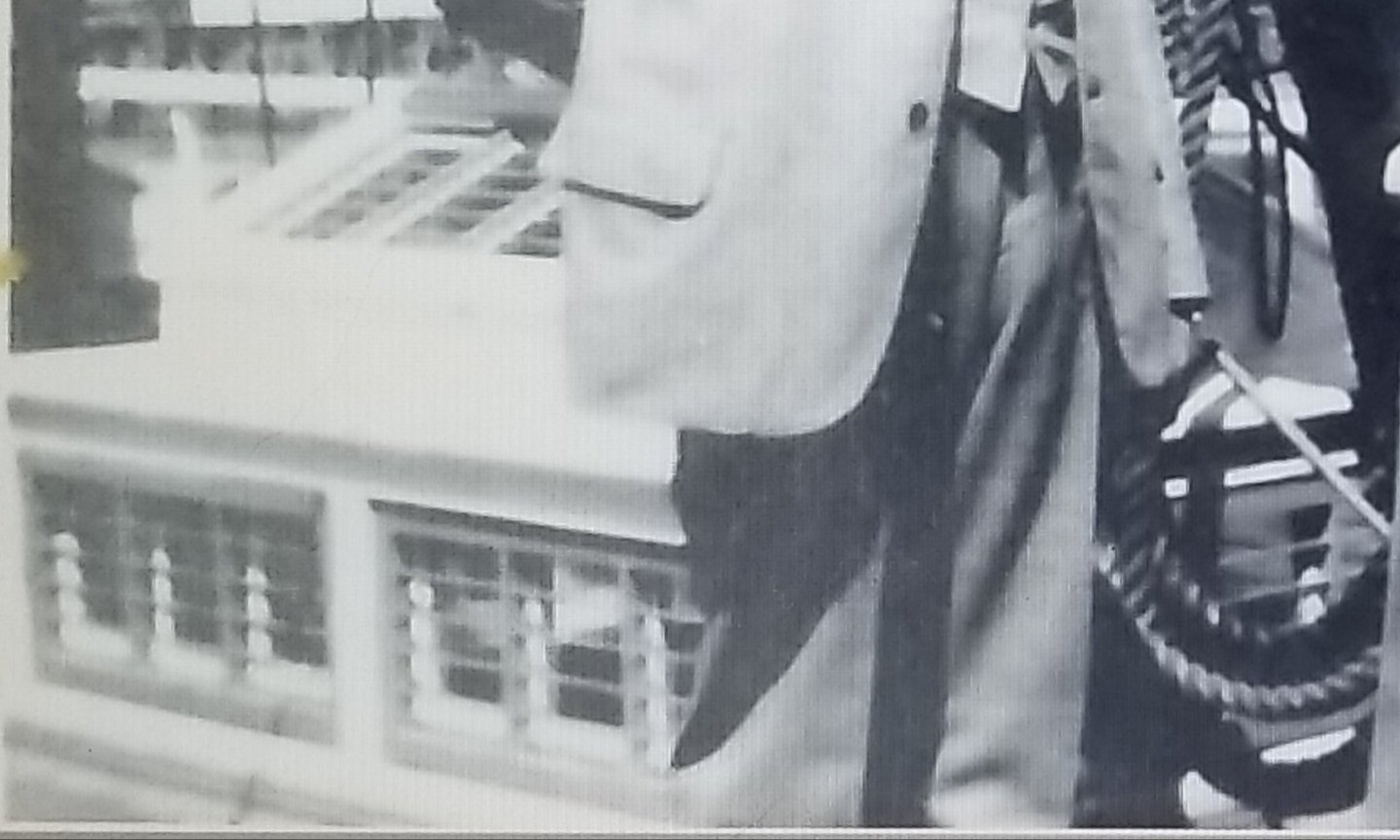-
Posts
2,168 -
Joined
-
Last visited
Content Type
Profiles
Forums
Gallery
Events
Everything posted by ClipperFan
-
Rob, Other than the patented windlass, I'd say yes. In this example the windlass is under the focsle deck but outside fore bulkheads. With all the complex gears of Emerson-Walker patented windlass, I would think McKay would have wanted it enclosed. To leave room inside for crew, I would think a separate enclosed room inside of the focsle would be made. Your thoughts?
-
Rob, Believe it or not, Crothers' illustration proves part of my point exactly. Look at the lightly dotted line above the windlass beneath. Now notice the twin ladders? They both end at that dotted line, showing that both "wc's" are fully beneath the forecastle deck. Either that or those ladders end up in midair... From the illustration, while the wc's are actually outside the forecastle bulkheads, like you said, they are both fully underneath the forecastle deck, which was my point. So, it looks like we're both half right.... 😉 I lightened up the drawings to make this easier to see. Just like I suggested doors to inside of forecastle are both inside, adjacent to each "wc" too. I would place both ladders a little closer to "wc" walls to make entrance doors to forecastle a bit easier to access.
-
Rob, It's harder for me to concentrate right now. Somehow, I strained my neck and it's a tough distraction. From what I've read, where McLean refers to forecastle height being at the main rail, he's dead wrong. As you and Vlad learned on Glory of the Seas, that's too damn low. It has to be at monkey rail height. Then, like with Glory there would have been an 18" splashrail, with a 1' waterway type shelf at the base surrounding the forecastle with the same elegant curving point for belaying pins as seen on Glory. One difference I have with portrayal of waterclosets is their being outside of the forecastle. To me, being in the wings of the forecasle implies a flush bulkhead with the 3' wide waterclosets being fully under the forecastle deck. As I've read, the area under the forecastle was sleeping quarters for use of the off-watch crew. As I now see this there possibly was two separate entry doors just inside the wings of the waterclosets and bigger sliding doors for windlass maintenance. If entrance to the waterclosets were inside, then twin ladders could be mounted on the outer edges. Now, since the entire area is closed in, would there have been some windows of any type for light?
-
Rob, Michael Mjelde told me that, as each Captain took over their craft, they could and often did change the appearance of their ships. Mike once recounted a dizzyiing number of times that had the colors of her structures changed at the whim of each ship's new commander. I can look to verify McKay's use of rich hardwoods in his packets but I'm sure that he did from everything I've read.
-
@Rick310 Cool book. I wonder if this is still a available? What simply amazes me is that while the hull's sheer and body plans may have been traced directly from McKay's own lines, critical components were entirely omitted. That, despite Duncan McLean's very specific descriptions of the seaworthy nature of these innovative rugged, nautical structures. I greatly admire the beauty of the Boucher models but they're still featuring a bare stem. The first model is from Museum of Fine Arts, Boston. The second is a twin at Addison Gallery, Phillip's Academy, Andover, MA. They look remarkably similar but their sail arrangements are different. In a way, Boucher Mfg. can't be faulted since, Donald McKay quite likely posthumously, pulled a Houdini on everyone with his unique bow construction.
-
@rwiederrich Rob, I took another look at the Boston Daily Atlas description of a 13' skylight installed on Staffordshire. It wasn't a single one as I first thought, but actually a doubled up 6 & 1/2' skylight pair. That gives me the impression that for some reason, the maximum length for such structures might have been 6 & 1/2'. Next, I will see if it's possible that two back to back 12-13' skylights will fit on the poop deck instead. The wheel house on my layout looks like it can be moved back a bit which just might make everything else fit. Just give me a day or two and I should have an answer for you.
-
@rwiederrich Here's an 1855 Scientific Magazine article on Emerson's improvement of his own windlass. This article's material does refer to the windlass's ability to "ungear." I also noticed that the alternative windlass I just shared doesn't even illustrate use of a capstan. It's looking more likely that Emerson & Walker's patent windlass is the correct choice.
-
@rwiederrich Not to throw a "monkey wrench" into the Emerson & Walker 1850 patent but... here goes. There's another windlass by mechanic C Perley, patented July 30th 1850 which also looks quite versatile. What I'm looking to find is any reference to "ends which ungear" the sole attribute described by McLean Here's the patent image with details
-
@rwiederrich great catch! I was able to confirm that this is Emerson & Walker's 1850 patented windlass. I hope you don't mind; I lightened up your Campbell print and found a three-dimensional print as well. Hard to believe McLean's brief description had anything else in mind, from his terse description.
-
Rob, To clear up apparently repetitive confusion on skylight dimensions, here are precise descriptions by Duncan McLean of several skylights installed on Donald McKay's third clipper Staffordshire. Remarkably, while she was under construction, a third deck was added and she was converted to a flush deck packet. For my skylight reconstruction I relied on two sources: Michael Mjelde's Glory of the Seas rear coach house roof plans and the sole useful image of a skylight on the ship herself. Michael's two skylight outlines measure 6' long × 4' wide. Since the photo shows apparent seating surfaces on both sides with a slight overhang, my sketch was 6' long x 4' wide. Center house structure was 5' long (inset 6" on both ends) about 2' wide by 1' high. My estimate of a large 10' long central skylight is just that. I'm still nailing down those dimensions based upon available poop deck space. I hope this helps clear up skylight dimensions.
-
@rwiederrich Drawing inspiration from your triple window treatment for the side, I revised that side window. It appears to balance out the door better this way. Here's the finished starboard side for the Stag Hound portico. To complete the series, both fore and aft are included as a pair and each individually. What astounds me about Rob's rapid craftsmanship is this. His lovely, delicate portico was entirely complete, long before I could finish my conceptual sketches! Now the race is on to complete my sketch of the 44' poop deck furniture. .. 😉
-
@rwiederrich I'm sharing my finished Stag Hound fore and aft portico concept. You were right too, a 1' overhang looks more balanced. It doesn't match the lovely version you built but maybe @Vladimir_Wairoa or @Luis Felipe might want to tackle this alternate concept instead. Next, I'll finish up the starboard side view and then it's on to the full 44' poop deck illustration.
-
@rwiederrich based on each of the 3 side staterooms being 7 feet deep, going from fore to aft, porthole #1 would be 3 & 1/2' back from the poop deck front (1/2 way to fore center of 1st stateroom) #2 would be 7' from #1 (3 & 1/2' from #1 stateroom aft center + 3 & 1/2' to stateroom #2 fore center). Then #3 would be 7 & 1/2' (3 & 1/2 from #2 stateroom aft center + 4' to 8' recess fore center) then #4 would be 10 & 1/2' from #3 (4' from 8' recess aft center + 3' beyond watercloset + 3 & 1/2' to #4 stateroom fore center) #5 is 9 & 1/2' from #4 (3 & 1/2' from #4 stateroom aft center + 6' to large stateroom #5 fore center). Meanwhile all deck prisms would be centered on the outer poop decks beginning 4 & 1/4th' from the 6 & 1/2 large apartment border & matching porthole spacing. It actually all works out very logically and precisely.... I think! 😉
-
@rwiederrich Beautifully done! This is just such a nice looking (dare I say delicate?) little structure. Probably the very first time this fascinating portico has been realized accurately for a Stag Hound model. Realizing that a lot of this is speculation (especially the upper railings) still, it's based on solid evidence from McKay's other ships. Regardless, you've created a lovely little portico, worthy of McKay's Pioneer craft of the California Fleet.
-
Rob, Another conundrum to resolve isn't a big one. It's where to locate what are basically little green spots and corresponding portholes for stern cabins under the poop deck. In this case, it would have been nice if Duncan McLean had given just a little more details than he did. All we know for sure is that the main deck portico is an enclosed entrance for stairs that descend 3' below. That leads to apartments under the poop deck. A sole dimension given is 32' long by a mere 13' wide by 6' 8" high. Yet, somehow each stateroom (of which I count 7) has their own deck light (prism) and side light (porthole). The only logical way that makes sense is if the large central space is some sort of formal dining area maybe with a kitchen at the end, where the smokestake is located. Behind this presumably is the single large stateroom with double berths. Then on each side are located other various single berth staterooms, water closets and recesses, each with individual doors opening into the large central room. It looks like the front of the poop deck is about 30' wide. Subtracting 13' leaves 17'. Divided in half gives us 8 & 1/2' width on two outer ends, narrowing as you approach the stern. Before the single large stateroom are two waterclosets (toilets). They could be 4' wide entrance by 6-7' length deep, placed sideways on each side. Then a stateroom, an 8' recess and two more staterooms. Since each has their own side and deck light, it makes sense to double these. That means a watercloset, a stateroom, a recess and finally two more staterooms. If I reduce the watercloset to 3' now I have just enough room for 3 equal 7' staterooms. Tight but it works. Figuring that the 8' recess might have had its own deck and sidelight, I count 5 prisms and 5 portholes per side in the stern. That's counting 2 for the single large double berth stateroom fit for a family. Let me know if you can follow my layout and if you can, does this sounds right to you?
-
Rob, I will double check dimensions on my skylight sketch, based on Michael Mjelde's Glory of the Seas coach house roof sketch. From memory they were each 6' long x 4' wide. His side view showed they appear to be 3' high. Look at the photo, there's seating surfaces on each side as well. FYI: top divisions of 8 sections are wrong. I later revised the top to match sides. There really were 6 divisions, not 8 as incorrectly illustrated.
About us
Modelshipworld - Advancing Ship Modeling through Research
SSL Secured
Your security is important for us so this Website is SSL-Secured
NRG Mailing Address
Nautical Research Guild
237 South Lincoln Street
Westmont IL, 60559-1917
Model Ship World ® and the MSW logo are Registered Trademarks, and belong to the Nautical Research Guild (United States Patent and Trademark Office: No. 6,929,264 & No. 6,929,274, registered Dec. 20, 2022)
Helpful Links
About the NRG
If you enjoy building ship models that are historically accurate as well as beautiful, then The Nautical Research Guild (NRG) is just right for you.
The Guild is a non-profit educational organization whose mission is to “Advance Ship Modeling Through Research”. We provide support to our members in their efforts to raise the quality of their model ships.
The Nautical Research Guild has published our world-renowned quarterly magazine, The Nautical Research Journal, since 1955. The pages of the Journal are full of articles by accomplished ship modelers who show you how they create those exquisite details on their models, and by maritime historians who show you the correct details to build. The Journal is available in both print and digital editions. Go to the NRG web site (www.thenrg.org) to download a complimentary digital copy of the Journal. The NRG also publishes plan sets, books and compilations of back issues of the Journal and the former Ships in Scale and Model Ship Builder magazines.

